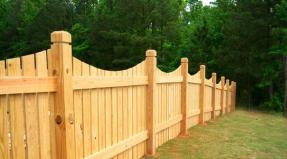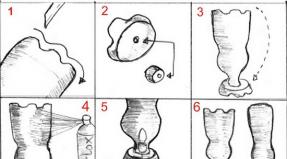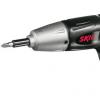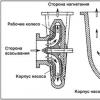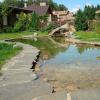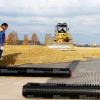How to install a shower drain
This is very convenient and saves space in the bathroom, since the cubicle is compact and takes up little space. To collect drains after taking a shower, use a tray that is installed with the shower stall, or a drain that is securely installed in the floor. Then the water flows through the ladder into the sewage system through pipes.
Such a system is very simple, convenient and durable. The main thing is to install the ladder correctly so that the water can drain freely. It is also important that everything is sealed to avoid flooding. In this article, we will tell you how to install a shower drain with your own hands, consider the option of installing it in the floor under the tiles, and also give photo and video instructions.
At the place of installation, the ladders can be divided into the following types:
- horizontal;
- vertical.
A horizontal ladder is more often installed in an apartment that is located in a multi-storey building, since often the sewer connection passes from the side, at a slight angle of water discharge into the sewer pipe. Thus, the water will go to the side, directly into the sewer.
The vertical ladder is suitable for owners of private houses and cottages, where the sewer can run under the floor. They have great bandwidth.

The shower drain kit is as follows:
- Siphon. It consists of a water seal and a dry / mechanical seal. This design serves to block unpleasant odors that can escape from the sewer. The dry seal is a float design that reacts when the siphon dries out and prevents fetid odor from entering the drainage pipe. When the water dries up, the float is lowered and the sash closes. A mechanical shutter is an anti-freeze design that is used in an unheated room.
- Decorative grill. It is installed on the body of the drain and rests on its surface. The surface of the grate on the outside is at the same level with the sides of the ladder.
- Drainage ring. If there is a rupture of the waterproofing, the ring will allow the water to go back to the drain through the hole in the ring.
- A clamping flange made of steel is used to ensure the tightness of the connection of the waterproofing to the body of the shower drain.
- Ladder body.

Before starting the installation of the ladder, it is important to select it correctly. Immediately before purchasing the equipment, pay attention to the following features:
Direction of water drainage.
- Bend diameter. There are often 2 options: Ø 50 mm and Ø 110 mm. It all depends on the diameter of the sewer pipes in the system.
- The height of the ladder will depend on the height of the floor where it will be installed.
If the kit does not include a hydraulic seal, it must be purchased separately. There are two options: a device with a dry shutter or a mechanical one. If the water seal dries out, the unpleasant odor will be blocked by a dry or mechanical seal.

The place where the ladder will be located must be chosen at the design stage. Why? Because the equipment will be floor mounted. Therefore, it must be prepared in advance. A pipe is installed in it, which will be connected to the sewer. It is important to make a slope of at least 3º so that the water flows through the pipe without obstacles. Then a recess is made into which the ladder will be installed. But there are two options for development:
- When a shower is installed during the construction of a house, problems should not arise. Indeed, in this case, the project includes the installation of a sewerage system, with an outlet for all means of communication. Therefore, the floor and the screed are made in such a way as to ensure the correct angle of water discharge from the ladder and the drain pipe is mounted.
- If the building has already been built, the question arises, where exactly to drain? You can make a stable flooring by raising the floor and drain the drain into the sewer system, or remove the screed by making a new drainage system.
The floor covering should have a slight slope directly to the ladder. Then the water will quickly go down the drain without accumulating in the shower.

You can place the ladder in the following places:
- In the center, where the slope of the floor should be on all sides towards the drain.
- In the corner when using a triangular ladder. Then the slope of the floor should be on all sides and directed towards the drain.
- On the edge where the slope will be in one direction only. In this case, a slotted ladder is used.

After you have decided on the choice of equipment and location, proceed to installation. All work can be done by hand without the help of specialists. For work you need to prepare:
- sifted sand;
- cement;
- material for thermal and sound insulation (foam is most often chosen);
- waterproofing membrane;
- glue or mastic;
- anti-slip tiles or mosaics from which the floor will be made.

If you are doing work on a completed building, the first step is to remove the top layer of the floor. A tile or other covering is torn off to the ground. Do this until you reach the concrete floor. After that, it needs to be cleaned.
Styrofoam is laid on the cleaned concrete. Its thickness should be at least 4 cm, and it itself should be quite tough. Do not forget that you need to ensure that the floor level is tilted to the place where the water will drain. To do this, use a level, checking each step of the installation. Also, in the foam, you need to make a cutout for the sewer pipe and the ladder.
In the place that you have chosen and where the pipe from the sewer is connected, install a shower drain. It must be connected to the sewer. It is important to observe a slope that will be directed towards the riser. To set the device at the required level, use the tools at hand or special adjustable feet. Using a spirit level, check if the grate is level with the floor.

Then everything is filled with sand-cement mortar. Thus, the ladder will be fixed. In order for the screed to adhere well to the surface of the device, it must be degreased with acetone or solvent. The screed layer is applied taking into account the slope required to direct the water to the drain. Each step of the installation is checked by the level.
To ensure the tightness of the drain, after the screed has dried, it must be carefully sealed. For this, you can use a silicone sealant. Since there will always be water on the floor in the shower, he should not let it through. Water should only drain through the drain.
In order not to worry about sealing and calculating the desired angle, you can buy a special acrylic or enamel pallet. It can be easily connected to the gangway without the need for finishing.

Now it is necessary to provide waterproofing. To do this, you need to fill the screed with a special waterproofing layer and "sink" the fiberglass seal into it using a special float. A layer of waterproofing must also be applied to the perimeter wall. The fiberglass mesh should be laid so that the canvas 10-15 cm runs along the wall. No need to cut it in the corners. Make a fold and glue it to the wall with waterproofing compound. Pour concrete again and make a screed, taking into account the slope to the ladder.

This is followed by finishing work. Apply mastic or adhesive and lay tiles or mosaics. It is important to take into account that the grate of the drain should be located at the same level as the cladding. It is very convenient to use a mosaic on a grid as a finishing material, since as it is laid, it can be cut in the place where the ladder is installed. After that, all seams must be sealed with a moisture-resistant grout.
Tiles are laid on the wall in the same way. Before laying it, it is advisable to make a waterproofing screed to a height of 30–40 cm.

It remains only to wait until it is completely dry. The drain is installed, it will provide a reliable drain of water into the sewer system. If you have any questions on the topic, then ask them at the end of this article. A specialist working on our website will provide you with advice.
Video
A series of video tutorials shows how to qualitatively prepare a place for installing a ladder and carry out its direct installation:

